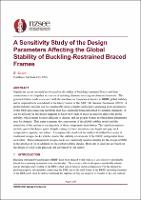| dc.description.abstract | Recent research has focused on the ability of buckling-restrained braces and their connecting elements to act together as a series of resisting elements to resist mechanism formation. This potential failure mode is known as BRBF global stability and is required to be considered by the latest version of the AISC 341 Seismic Provisions. A global stability analysis can be considerably more complex and require analyzing many more parameters of the BRB and connecting members than has commonly been done. It can be difficult for the design engineer to know how each of these parameters affects the global stability, which might be most efficient to change, and the proper bounds in which these parameters can be changed. This paper examines the components of the global stability model and the sensitivity of the system to varying each of these variables in isolation. The varied parameters include, gusset thickness, gusset length, casing stiffness, insertion zone length and gap, neck compressive capacity, and others. It will compare the results of the analytical method to the global stability failure of a full-scale BRB test performed by the author. A set of simplified design parameters will be presented that are most likely to produce satisfactory results for the global stability of a BRBF. | |

